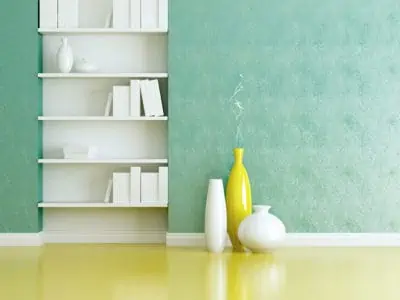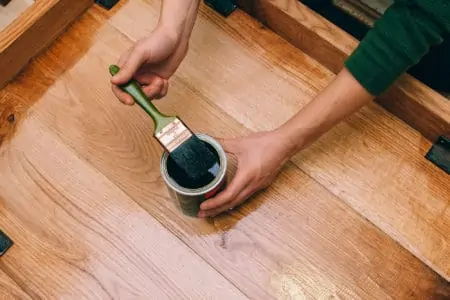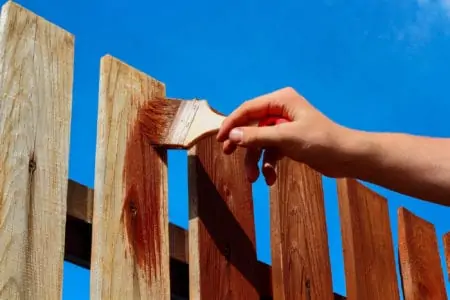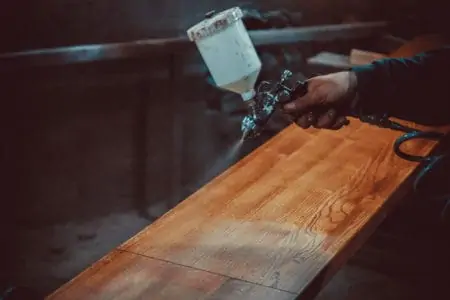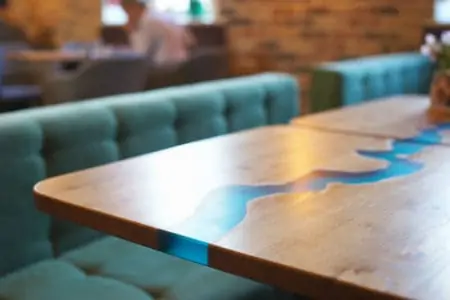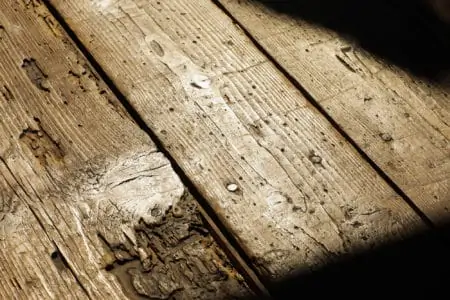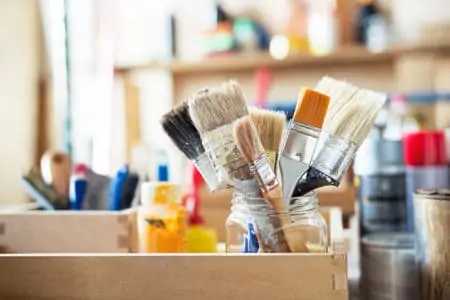Not sure if a sponge wall painting technique would fit your home decor? Sponge painting walls can have both a relaxing and dramatic effect, depending on the colors of choice.
And, with some practice, it’s easy to pull off! You can transform any space with the right idea. So, let’s look at a list of sponge painting ideas to inspire you.
Key Takeaways
- Sponge painting adds texture and hides imperfections on walls.
- Use natural sea sponges and maintain consistent pressure for best results.
- Experiment with different colors, patterns, and techniques for unique effects.
- Alternative painting techniques include strié and rag rolling.
Sponge Painting Ideas
Depending on the room vibe you’re going for, there are many different sponge painting color combinations to try. Below are 15 gorgeous examples of how you can embed the colors and the technique throughout different rooms across the house.
1. Patterned Feature Wall in Bathroom
If you worry painting a room with the sponge technique is too much work, there are some easy workarounds. You can get playful with the patterns of your choice but also choose simple vertical lines for a fast paint job that result in an interesting accent wall.
2. Faux Wallpaper Look
Using a technique and appearance like the previous example, you can also use a sponge to create the illusion of wallpaper. Pick from a wide range of colors and patterns to transform your wall.
3. Soft Texture
Any space can be given an old-world feel by using the “broken finish” or “color washing” techniques, and it’s surprisingly easy to accomplish.
Once the base color has been painted in the desired shade, add an even, translucent layer of glaze over the top.
4. Playing with Color
There’s a notion that sponge-painting techniques are only suitable for blending a maximum of two colors. But don’t stop there!
Blend in multiple shades of the same color and add another color that matches. For instance, the combination of lighter and darker shades of purple work well with gold.
5. Faux Tiles
I love stencil work. And, when paired with a sponge, you can create beautiful effects.
You can also make your own stencil using a ruler, a pencil, scissors, and a cardboard piece to make cut-outs. This honeycomb pattern is a nice idea, but there are plenty of other shapes or designs you can go with.
6. Using Different Patterns in the Same Color Scheme
If brick walls aren’t an option and brick wallpaper doesn’t sound right either, how about creating a faux brick effect using the sponge technique?
You can also play around with wall patterns in the same room, as you can see pictured. But retain the color schemes throughout the room if you don’t want to worry about matching colors or buying new paint.
7. Color Wash
You can pick a wall color based on the existing upholstery for amazing color consistency.
The basic sponge technique is easy to master, and you can create stunning visuals in the living room. The glaze’s hue echoes the upholstery’s stripe pattern, tying the room together with a single thread.
8. Patina Metal Effect
You can always go with a patina metal effect on the walls for an industrial-themed room. You can use Craig & Rose’s Copper Effect Paint or something similar.
The weathered effect of the walls would pose as a magnificent background for some metal floor lamps with exposed bulbs or metal and wood coffee tables.
9. Faux Faux Sponge Painting
Applying a layer of sponge paint over another layer of sponge painting can also render a very cool effect. It creates the illusion of very interesting 3D textures. It also gives you the chance to combine multiple colors or different shades of the same color.
10. Triangle Pattern
Geometric patterns will never go out of style, so they’re a no-brainer for easy wall decorating. And, triangle patterns can draw attention to an accent wall without making it obvious.
Make your stencils to create these triangle patterns, and if you’re feeling creative, you can go with other shapes.
11. Ombre Effect
The most complicated part of painting in an ombre effect is settling for a color. This gradient-like effect can easily be obtained with the sponge technique.
Choosing a bright and dark shade of the same hue is necessary to keep to one color. Remember that the more substantial the hue difference, the more dramatic the result will be.
12. Mediterranean Sponge Effect
The sponge painting technique can go hand-in-hand with natural Mediterranean colors. For warm and relaxing bathroom wall paint, go with dark shades of beige or sand tones. These tend to remind us of the amazing feeling of dipping your toes in the sea.
13. Faux Brick
Let’s welcome another example of faux brick paint using the sponge technique. Whether you do it on an accent wall or every wall in the bedroom, the effect will be outstanding and authentic.
14. Old Galvanized Metal Effect
. Galvanized metal may not be a suitable match for French cottage or Boho style homes, but if you’re going for a more rugged appearance, you could make it work. Gray is an excellent paint color for this effect. You can dab light over dark shades for a truly realistic metal appearance.
15. Playing with Metallics
Metallic effects are ridiculously easy to achieve using the sponge wall painting technique. You can go with an accent wall and give it that cloudy sky effect.
It could also work for a bedroom ceiling. I love the addition of gold paint to this mix. It feels like the sun is emerging from behind the clouds.
Tips For Sponge Painting Walls
To make sure your sponge painting walls are on-point, consider the following tips:
- Use natural sea sponges instead of kitchen and bath ones for the best effect.
- Choose a sponge size that’s suitable for the area you want to paint.
- To add or remove glaze, dip the sponge in a solvent.
- Leave the sponge in a solvent if you’re taking a break during the paint job.
- Maintaining consistent pressure when applying paint with the sponge is key for an even finish.
- Don’t dab the walls randomly when applying the paint if you want an even finish.
Alternatives to Sponge Painting
There are tons of cool painting techniques you can try out for a textured effect. But here are a few common ones.
Strié
The French word for streaking is strié. It refers to a paint method that forms vertical or horizontal lines to give the appearance of linen material. When done right, it’s a beautiful way to bring a sense of coziness and texture to any room.
Rag Rolling
The painting technique known as rag rolling is exactly what it sounds like. It’s about rolling wet paint on the wall to create texture and depth. Because it’s so subdued, this concept may be used in any aesthetic without detracting from the overall look and feel.
FAQs
So, Will You Try Sponge Painting?
Sponge painting walls isn’t necessarily a complicated thing to master, but there are some things to keep in mind if you want the result to be top-notch. Draw inspiration from today’s gallery and choose the colors that will make your house feel like a home.
